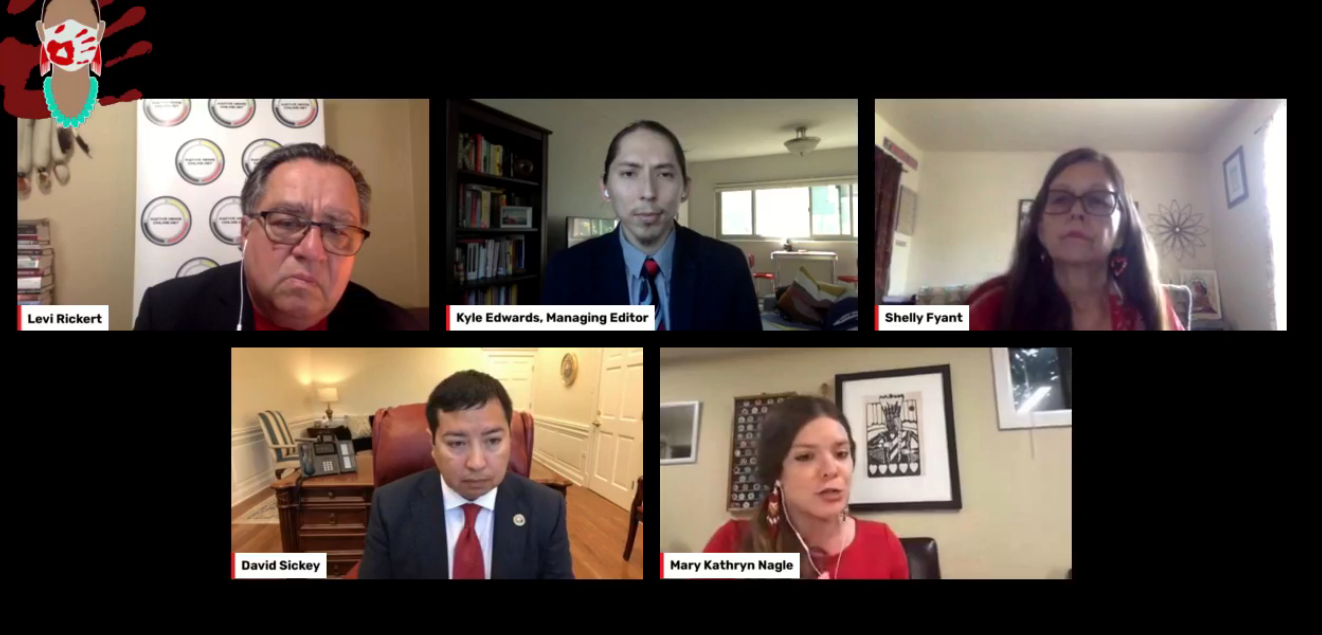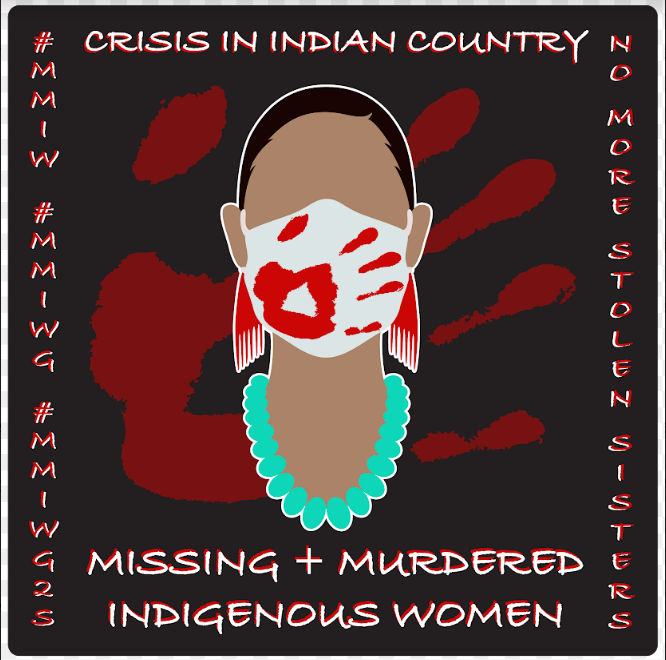
- Details
- By Jenna Kunze
On Native News Online’s Wednesday evening live-streamed event “Crisis in Indian Country: Missing and Murdered Indigenous Women,” three panelists from across Indian Country echoed factors of jurisdictional issues, a lack of data, and the age-old victimization of Indigneous women dating back to first contact as contributing factors to the crisis.
“It's not an epidemic,” panelist Shelly Fyant of the Confederated Salish and Kootenai Tribes said of MMIW. “It's not a new crisis. It started with the invaders arrival to Turtle Island. It's just been more publicized now thanks to the media.”
The forum— moderated by Native News Online publisher Levi Rickert (Potawatomi) and managing editor Kyle Edwards (Anishinaabe)— included panelists Chairman David Sickey of the Coushatta Tribe of Louisiana, Chairwoman Shelly Fyant of the Confederated Salish and Kootenai Tribes in Montana, and Mary Kathryn Nagle (Cherokee), an attorney who practices Indian law. Interior Secretary Deb Haaland also contributed a pre-recorded video to Native News Online.
CLICK TO WATCH THE PRE-RECORDED FACEBOOK PROGRAM
The one and a half hour discussion was planned for May 5, National Missing and Murdered Indignous Persons Awareness Day proclaimed by President Joe Biden and signed in a resolution by the U.S. Senate on April 29.
Native women face murder rates more than 10 times greater than the national average, and more than 5,000 American Indian and Alaska Native women are missing, according to the most recent data from the U.S. Department of Justice. The agency also reported that 55 percent of Native women have experienced domestic violence in their lifetime.

In response to why MMIW has gained visibility over the last few years, Nagle, who is a partner at Pipestem Law, a firm specializing in tribal sovereignty of Native nations and peoples, said it’s because “we’re just now collecting the data.”
“We're missing a lot of data,” she said, noting that oftentimes when a crime is committed against a Native woman, local police do not report the victim’s race as Native American or Alaska Native. “But the data we do have is so incredibly alarming...the national non-Native news media is picking up on the data,” Nagle continued.
Nagle said that attention is what motivated the Senate to create and pass Savanna’s Act last year, directing the Department of Justice to review, revise, and develop law enforcement and justice protocols to address missing or murdered Native Americans.
Chairman Sickey encouraged listeners to give credit to tribal nations and communities recognizing that there's a need for awareness, and deploying modern communication tools in rural areas to spread the message of MMIW.
“I think where the traditional media falls short, tribal nations are taking the opportunity to identify areas where they can get information across through channels that were not typically utilized before,” he said.
What are some of the barriers that contribute to the MMIW crisis?
In a word: "Jurisdictional," Nagle said.
“If a Native person on tribal lands is murdered by a non-Native, the tribe does not have criminal jurisdiction,” she said. “And that's a huge crisis. The federal government does. They really should be investigated and prosecuting cases, and they most often don't.”
As a result, she said, it often falls to the victim’s families to pick up the slack where understaffed and under resourced federal agencies fall short.
“By and large, our families in Indian country, have to do the investigations themselves,” she said. “The burden is on them to investigate, and that is so so so incredibly challenging to have to be collecting the evidence yourself, doing witness interviews, and then begging law enforcement to do an investigation, but that's the position they're in.”
What is being done to right these wrongs?
In Montana, Fyant said there is a missing Indigenous persons task force with representatives from all of the eight tribes in the state. They also developed a Native empowerment and self-defense training program designed for Indigenous women to directly reduce rapes of rape, murder, and kidnapping. Fyant said the group just graduated its first eight facilitators.
In Louisiana, Sickey announced during the live stream that Louisiana Gov. John Bel Edwards yesterday signed an executive order creating a MMIWG task force. “These are tangible efforts being made down here in the south, and I'm very proud of that fact," Sickey said. Additionally, the chairman is slated to meet with President Biden during a scheduled visit to Lake Charles, Louisiana, 45 minutes west of the tribe’s headquarters on Thursdayafternoon. He said he plans to thank Biden for his support “and his affirmation and of tribal self governance and self determination, and his long history of supporting Native American civil rights matters.”
Nationally, Sec. Haaland—donning red in support of MMIW day— said she believes America is at an inflection point in her pre-recorded video streamed during the panel.In her third week on the job as head of the Interior, Haaland announced the creation of a new unit to investigate and solve cases of missing and murdered Indigenous women. The new unit, Missing & Murdered Unit (MMU), was created within the Bureau of Indian Affairs Office of Justice Services (BIA-OJS). It will help put the full weight of the federal government into investigating these cases and marshal law enforcement resources across federal agencies and throughout Indian Country.
“We have a president who has promised to prioritize this issue, and ensure that Indian tribes have a true seat at the table,” Secretary Haaland said. “The Interior is determined to marshal our resources to implement these laws to finally address the crisis of violence against Indigenous peoples. We're putting the full weight of our federal government in a cross departmental Missing and Murdered unit."
What more can be done?
Looking ahead, Nagle said that what’s sorely needed to advance policy is a Native political appointee in the Department of Justice (DOJ) whose mission it is to address this crisis.
“These US Attorneys are political creatures...they don't want to take a bunch of cases that might make the tribal community nearby feel really good about visibility and accountability for murders of Native women, but they're thinking about their political careers, and so that's the real disconnect right now,” Nagle said. “At the end of the day, we might have a really great case file from the cold cases team ... but if we don't have someone at DOJ who says ‘It's your job, US Attorneys, you go after these cases.’ We need that messaging, and we haven't had that historically at DOJ.”
Chairwoman Fyant said another area of improvement could be to build on the Missing and Murdered Indigenous Person Coordinators’ initiative, that in 2019 placed coordinators in U.S. Attorneys’ Offices in: Alaska, Arizona, Montana, Oklahoma, Michigan, Utah, Nevada, Minnesota, Oregon, New Mexico, and Washington state.
“What I found it really ironic that North Dakota wasn't one of the 11, and you know there's a lot happening there,” Fyant said. “Theres a lot of pipeline activity over there, which establishes camps, which leads to sex trafficking (and) human trafficking.” If she were meeting with the president tomorrow, she said she would ask for additional funding to the MMIP Coordinators program.
Hope ahead
In closing, panelists said the new administration’s promise to represent Indian Country—paired with Sec. Haaland’s appointment to one of the highest level cabinet positions—makes them hopeful for a heightened level of attention and resource allocation towards the crisis.
“We have some very aggressive, robust support from the highest levels of the government” Chairman Sickey said. “Now is the opportunity to take advantage of that and move forward in the most progressive and positive and urgent way possible.”
During the program the "Say Her Name" trailer was shown.
The program was sponsored by the Coushatta Tribe of Louisana, the Navajo Nation, the Gathering Thunder Foundation. Special thanks to Tom Rodgers, president of the Global Indigenous People’s Council.
CLICK TO WATCH THE PRE-RECORDED FACEBOOK PROGRAM
More Stories Like This
Native News Weekly (August 25, 2024): D.C. BriefsUS Presidents in Their Own Words Concerning American Indians
2026 Native American 40 Under 40 Class Announced
Monday Morning: (January 5, 2026): Articles You May Have Missed This Past Weekend
Native News Weekly (January 4, 2026): D.C. Briefs
Help us defend tribal sovereignty.
At Native News Online, our mission is rooted in telling the stories that strengthen sovereignty and uplift Indigenous voices — not just at year’s end, but every single day.
Because of your generosity last year, we were able to keep our reporters on the ground in tribal communities, at national gatherings and in the halls of Congress — covering the issues that matter most to Indian Country: sovereignty, culture, education, health and economic opportunity.
That support sustained us through a tough year in 2025. Now, as we look to the year ahead, we need your help right now to ensure warrior journalism remains strong — reporting that defends tribal sovereignty, amplifies Native truth, and holds power accountable.
 The stakes couldn't be higher. Your support keeps Native voices heard, Native stories told and Native sovereignty defended.
The stakes couldn't be higher. Your support keeps Native voices heard, Native stories told and Native sovereignty defended.
Stand with Warrior Journalism today.
Levi Rickert (Potawatomi), Editor & Publisher

